Text
Bibliography
Scholarly resources
Cartmell, D. and Polasek, A.D. 2019. A Companion to the Biopic. New Jersey, Wiley-Blackwell.
Dalton, M. M. and Linder, L. R. 2005. The sitcom reader: America viewed and skewed. New York: SUNY Press.
De-Jong, W., Knudsen, E. and Rothwell, J. 2014. Creative documentary: theory and practice. London, Routledge.
Kilborn, R., Kilborn, R.W. and Izod, J. 1997. Confronting reality: An introduction to television documentary. Manchester, Manchester University Press.
Koshi, H. et al. 2013. Discussion on Using Mockumentary Staging Techniques in the Creation of Frightening Imagery. International Journal of Asia Digital Art and Design Association. 17(4), pp.111-117.
Kriger, J., 2012. Animated realism: a behind the scenes look at the animated documentary genre. Oxford, Taylor & Francis.
Nichols, B. 2001. Introduction to Documentary. Indiana, University Press.
Rosenthal, A. 2007. Writing, directing, and producing documentary films and videos. Illinois, SIU Press.
Roscoe, J. and Hight, C. 2001. Faking it: Mock-documentary and the Subversion of Factuality. Manchester, Manchester University Press (USA).
Ward, P. 2006. Documentary: The margins of reality. New York, Columbia University Press.
Wallace, R., 2018. Mockumentary Comedy: Performing Authenticity. New York: Springer.
Docu-Films, Television and Other Media
All 4. 2019. Mark and Jeremy’s Funniest Moments. [Online]. [Accessed May 2020]. Available from: https://www.youtube.com/watch?v=kYkU9KNEpB0&feature=emb_title
Asian Provocateur. 2015. Netflix. 30 Sept.
BBC Three. 2018. The Last Kurupt FM Set Ever. [Online]. [Accessed May 2020]. Available from: https://www.youtube.com/watch?v=jR0cOiS-k9o&feature=emb_title
Charty992. 2010. Best of The Office Series 1. [Online]. [Accessed May 2020]. Available from: https://www.youtube.com/watch?v=5b-DsPazO9c&feature=emb_title
FitriHadi. 2013. Changing Batteries – The Saddest Story 3D Animation. [Online]. [Accessed April 2020]. Available from: https://www.youtube.com/watch?v=O_yVo3YOfqQ
Fyre. 2019. [Documentary]. Chris Smith. Dir. USA: Library Films
Got Talent Global. 2016. Kseniya Simonova Incredible Sand Art On Ukraine’s Got Talent. [Online]. [Accessed April 2020]. Available from: https://www.youtube.com/watch?v=9zLa-o7ZeiQ
Global Heath Media Project. 2016. The Story of Ebola. [Online]. [Accessed May 2020]. Available from: https://www.youtube.com/watch?v=XCrOde-JYs0
Global Heath Media Project. 2011. The Story of Cholera. [Online]. [Accessed May 2020]. Available from: https://www.youtube.com/watch?v=jG1VNSCsP5Q
Guardian News. 2020. Italians dance and clap as toughest coronavirus lockdown measures lifted. [Online]. [Accessed May 2020]. Available from: https://www.youtube.com/watch?v=oVsTnCSYAAQ
Hislop, W. 2020. Your Aunt at the NHS Clap. [Twitter]. 7 May. [Accessed May 2020]. Available from: https://twitter.com/willdhislop/status/1258457955189641224?s=21
Metawave1975. 2014. Come Fly with Me – Ian Foot - Ideology. [Online]. [Accessed April 2020]. Available from: https://www.youtube.com/watch?v=W-uMGuQrvQA&feature=emb_title
Miranda. 2009. BBC. 9 Nov.
Mr G. 2014. [Film]. Chris Lilley. Dir. Unknown.
Nanook of the North. 1922. [Documentary]. Robert J Flaherty. Dir. USA
NBC News. 2020. See Inside COVID-19 Hospital, Filmed by Wuhan Resident. [Online]. [Accessed May 2020]. Available from: https://www.youtube.com/watch?v=1U1VYck6KOo
NearlyFriendly. 2012. Come Fly with Me – Intro. [Online]. [Accessed April 2020]. Available from: https://www.youtube.com/watch?v=hvzBNbxtE6g&feature=emb_title
Onyad. 2016. La Sortie de l’Usine Lumiere a Lyon. [Online]. [Accessed May 2020]. Available from: https://www.youtube.com/watch?v=HI63PUXnVMw&feature=emb_title
Shane. 2018. Ghost Hunting in A Haunted Toy Store with Grav3yardgirl. [Online]. [Accessed May 2019]. Available from: https://www.youtube.com/watch?v=eExAkGrcoQ8
Siddeshwari. 1990. [Documentary]. Mani Kaul. Dir. Unknown.
Tedx Talks. 2015. Confessions of a Wildlife Filmmaker. [Online]. [Accessed April 2020]. Available from: https://www.youtube.com/watch?v=S3SnIMZ43EQ
Tiger King. 2020. [Documentary]. Eric Goode and Rebecca Chaiklin. Dir. USA: Netflix
Unknown. 2017. How Filmmakers Are Changing the Perception of Animation. London, Pebble Studios.
Yahoo Finance. 2020. Grocery stores struggle to keep up with demand amid Covid-19 panic buying. [Online]. [Accessed May 2020]. Available from: https://www.youtube.com/watch?v=rDzrAVjtbKY
0 notes
Text
Evaluation
Outline:


Update 11/05/20 Main content, explained -
Interviews: I will adopt the best or most controversial segments of an interview and use them without context to build tension and 'hook’ the audience in. From the subject interviews I have now, examples of this might include:
1) ‘My money, my phone, my internet ain’t shit...“When the last tree is cut, the last fish is caught, and the last river is polluted; when to breathe the air is sickening, you will realize, too late, that wealth is not in bank accounts and that you can't eat money.”’ - Quoted by interviewee SS20T
2) ‘I think we’ll be even more socially distanced than before all this’ - Interviewee 2G01B
3) ‘...It’s man-made...I wouldn’t say I agree, but I wouldn’t say I disagree either. It’s a possibility’ - Interviewee 2G01B
Whilst these aren’t necessarily scripted (I haven’t planned them) I think using controversial or dramatic segments will build arrest my audience from the start and make them interested in watching the rest of the series. Even in the current circumstances - where these ‘pandemic’ narratives have become over-saturated.
Archive footage: This footage will not be my own.
These clips will be distorted and overlapping. The news will be the main source of archive footage I adopt here. Clips of news as it identifies its first fatalities and rapidly grows across Britain and the world. Rapid cuts will move between the two to reveal a build up to something unknown to the viewer. Adopting a crescendo style epic to build tension, too, will add to the enigma of the sequence.
In using the 999 call, I believe this will be useful in constructing an authentic message and inviting the viewers into the type of crime or detective theme I aim to create. The title itself ‘the story of an invisible killer’ highlights a narrative using similar conventions. We’ll slowly unravel the life of Covid-19, how it began, how it spread and it’s victims - in a much similar set up to a murder-based docu-series. The titles will ultimately ‘climax’ and end all tension before we return back to a state of equilibrium. Perhaps some establishing shots and tracking shots can highlight the world as we knew it before. This is overlaid over the voice over of an interviewee as they begin to unravel the story of the virus from its onset. This will take up the last few minutes of the narrative.
Update 16/05/20 Mini teaser:
youtube
Update 17/05/20 Feedback:
2G01B: Well edited. A current and gripping story.
WDL40: You explore themes of global, economic and political concerns well. It flows nicely and I can see where it all ties into the ‘invisible killer’ narrative. I would like to see some more interview clips!
[Interviews are currently available to view on the One-drive shareable link.]
D_D64: All is good. I would have liked to see some use of the title in the typography. Maybe starting with ‘Outbreak’ but eventually fading out the first part so all that is left is ‘break’.
Critical Summary:
How successfully did I meet the criteria?
1) Effective project design - whilst I didn’t execute my final documentary project idea, I most certainly had a lot of fun conceptualising and pre-planning it. Instead of delivering a 4 minute pilot, I invested my time into prepping for it through scripts, vision boards, test shots and more. Doing this allowed me to visualise how the final product would be and ‘fine tune’ any irrelevant or unnecessary ideas I had originally planned for. I believe this pre-production element also allowed me to come up with a solid, attention grabbing pilot sequence - ‘hooking’ audiences into a docu-series which combats topics of crisis. I would suggest, thus, that I was successful in this area of research and am happy with the research I conducted.
2) Research practise methods - This area was a lot harder to attempt. Considering that my idea was continually evolving, sometimes I found this a little challenging to document. For example, I perhaps didn’t mention how I plan to ‘animate’ parts of my project. I liked the idea of a sand artist or a sketcher to illustrate my work through ‘in camera’ techniques rather than using software like After Effects or Adobe Illustrator. This is because I felt as though it would be more suited to my authentic and personal approach, giving a sentimental feel to each segment.
Initially, I attempted to make my own sketches. Though, I realise that this not only would be extremely impractical (and time consuming!) but also quite tasking as I am not an artist so would need a lot of test-products and practise. Then, my idea was to to ‘hire’ (or rather ‘borrow’) an artist and credit their work within my docu-series. However, once again, the process of sourcing a voluntary artist would be extremely time-consuming and challenging as creatives deserve to be paid for their work and I would have very little to offer. Finally, I opted to resign from this idea within my 4 minute pilot and stick to conventional documentary making. This allowed me to conceptualise the idea, without actually having to execute it; and, given the short time scale, this was probably for the best!
On the other hand, however, my research in ideas and themes is present - highlighted through my ‘Inspiration’ blog posts. I would say that the original idea evolved tremendously as a result of continual research and practise. At times, watching non-related shows and YouTube clips would inspire my work to take a different turn. Likewise, researching and reading different approaches, ideologies and theories regarding the practice of documentary making too helped construct my final project. Throughout this project, I aimed to vary my research in author, date and style. This, I believe, is evident in my final project which was shaped from the origins of a mock-documentary with comical elements at its forefront, to a tech-and-edit-heavy docu-series reflecting on how the virus effected us all. The hands-on approach too guided my research and thus, whilst I did struggle in this area, I do believe I did confidently and successfully execute this brief within the pre-production of my documentary.
3) Critical analysis review - I would certainly agree that I used a variety of sources to aid and support my research. Whilst most of my sources were books (sourced online), I enjoyed studying varying topics, including: documentary origins, the authenticity of documentary making, modern practices and much more. These scholarly texts were useful to some degree in understanding the theory behind this practical art of documenting - and, in some cases, fabricating - real-life stories. However, the skill of documentary making lies in the practical skills too. So, I also used visual mediums like YouTube and Google-sourced images to help manage my understanding of documentaries more closely. This was especially important as my pilot would, once complete, be uploaded to a visual platform like YouTube.
It seemed that this decision was the right one. Not only did I believe that YouTube (as the second most popular social media site) could attract a wider target demographic but also, my market agreed that my docu-series felt fitting for a platform like this one.
On the contrary, however, I examined pre-existing documentaries like Tiger King and sitcoms like The Office UK which have established distribution companies, to inspire my hybrid genre. Where I will be tackling issues concerning the virus alone, this will be rather dark and upsetting; almost like a crime investigation using interviews and personal accounts to illustrate the era. On the other hand, I will attempt to break this up with comical or up-beat bursts of footage as a way to showcase that ‘every cloud has a silver lining’.
To summarise, thus, I did use various resources - both scholarly and non-academic sources - to produce my finalised concept. I feel knowledgeable on delivering and executing this piece as a ‘shreditor’ now, but, simultaneously understand the inner workings of ‘what makes a documentary...a documentary’.
4) Advance practical skills - Whilst I enjoyed the idea of the ‘shreditor’ role, I was a little surprised at its intensity. Of course, I didn’t (in the end) construct a practical piece to submit. However, even in the initial planning, and then creation of the test shots, the shreditor role had its challenges.
In my previous experience of working in teams, I have definitely learnt a lot. From making compromises and sharing unified responsibility, to the delegation of a team-production - I believe that this opportunity allows us to individually specialise at what we do best, and create a project which resembles the best of our skills. In single-handedly running each role (and thus bearing its responsibility too), however, even the simplest of tasks became challenging. To me, the process was harder than anticipated because I was responsible for all sides of pre-production, production and post. Even in my test shots I found it challenging to set up and film, when this wasn’t even half of the equipment I wished to use initially!
Perhaps in finding these limitations, though, I learnt a valuable lesson that I otherwise would have disregarded. As a single documentary maker, the equipment I wished to use would be highly unrealistic as I would’ve found the process of transportation and setting up extremely challenging. Not only would this significantly eat into my time, but also cause issues with running the shoot i.e. expecting to film and manage sound simultaneously. However, as noted in an earlier blog post, I would require the assistance of my peers and to support me in the filming process i.e. in sound management. This would limit the time I would spend in fixing any issues I had during the shoot as well as lift the pressure a little. Meaning that my time would be solely on the film making and subject.
5) My final review - Reviewing and critiquing my 2 minute test piece allows me to understand my ideas in the ‘real world’ - advancing from the simplicity of my pre-visualisation to the actual docu-series itself.
What I found with the filmmaking is that sound is an over-whelming pain which I did not consider for! I didn’t anticipate how good the mics on my phone and camera were as they picked up small sounds like birds in my neighbours garden or my fish tank (strange!) in the background of my interview with my mum. The distorting of sound compromised some of the shots I took and would’ve been greatly problematic for the real pilot. However, in testing locations which worked / didn’t work and how these undesirable noises could be avoided (using sound covers for example), only led me to a better final production...or that which will come after lockdown.
Furthermore, I depended a lot on archive footage. Especially when cutting different segments of audio together, archive visuals were necessary to hide this. Likewise, in the real edit, using Avid will be useful for brightening and contrasting shots and adding colour where necessary.
I also noticed that studio lighting will address some of the lighting issues I had and so will be a (new) requirement I will have to consider. Especially for the cinematic look I wish to adopt, this is especially important! Moreover, I will need a camera that can adjust its focal length to enhance this. Using my own Canon meant that I was limited in the visual effects, though with the BMPC, I feel more confident in playing around with the settings and making a more visually dramatic piece!
I enjoyed making it and whilst my production time was limited (I constructed it over the space of a day!) I found it beneficial in my practical understanding. I hope you can see the development of my idea over the past few months and are on board with my idea. Hopefully I can execute the vision I have in mind and produce a high-quality docu-series aimed to enlighten and educate the broad target market that is those who fell victim to the 2019-2020 global pandemic: Coronavirus.
0 notes
Text
Blog 12 - Pre-visualisation #2 and samples
In my second pre-visualisation, I began testing out my ideas in various ways. From shooting myself to re-writing scripts, I created various sample pieces of what could be a final project. Below are some exemplary pieces that I made during my pre-production and planning.
Scripting:
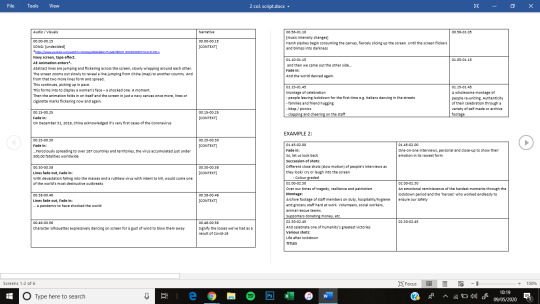
Interviews -
Kilborn et al (1997) observes that a documentary’s purpose is ‘to explore the hard, awkward questions more deeply and more critically than other branches of media do (or can)’ (p. 6). For this reason, I decided to create some pre-planned interview questions to objectively - and in some cases subjectively - probe my my subjects. This was in order to serve practicality (i.e. reduce time wasted on set, spend my time ensuring the subject felt comfortable, etc). As well as remain flexible, challenge my subjects as well as gain the most authentic answers.
The questions came in various forms (see image below) to ensure that I could really determine the true emotions felt by each subject and, more importantly, present this to my audience. I also left room for spontaneous questions* to be asked, depending on the subject (i.e. how open they felt with sharing their personal lives, the responses they had and so on).
These are some example questions I might ask during the one-to-ones.

*Example - if someone talks about telling their children/grandchildren about this crisis, I might ask ‘If you could look back on this time in ten years, how would you describe it to yourself to remember this time in all its glory?’ to encourage individual engagement with the project.
[SEE PREVIOUS BLOG FOR EXAMPLE ANSWERS]
Test shots:
1) Before lockdown took place, my project was going to be set in Leeds, and especially within the University itself. Having some access to staff-only areas such as the kitchens and staff-rooms, I believed that I could really make use of these ‘non-student’ places to make my docu-series fresh and exciting. I had taken some establishing shots around the university to help work out the locations I felt would be good public ‘filming spots’. Below are just a few examples of some images I got. Others were too large to put on this file.
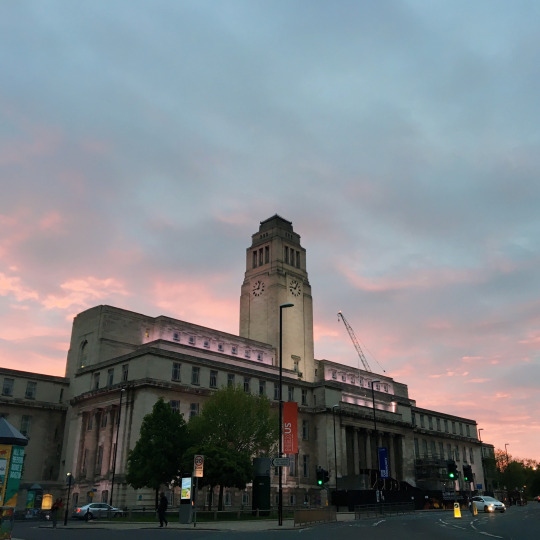



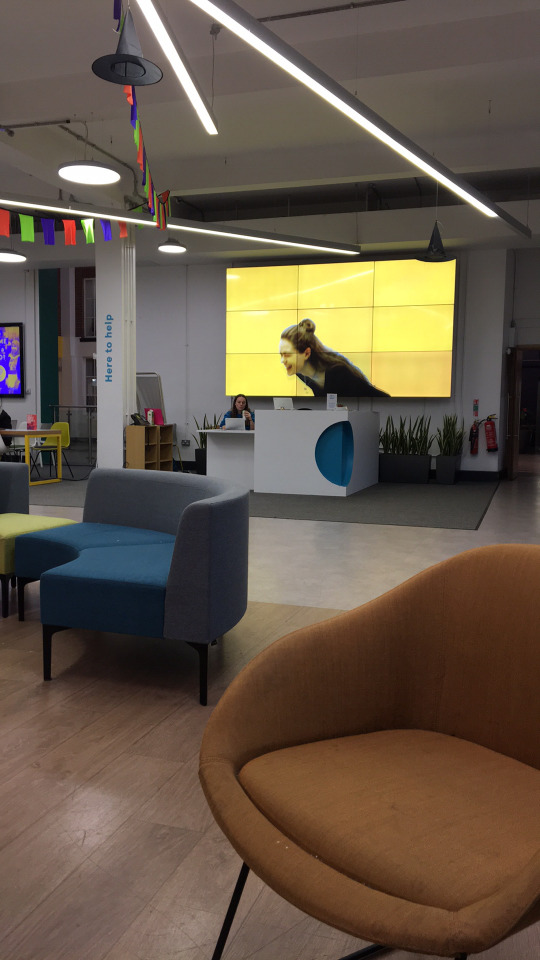
All of the above images were taken on a DSLR (Cannon 6D) camera or iPhone 6s. If I could re-do these, however, I would opt to use a video camera (BMPC) and take stills from the stable shots I film. Making it easier to establish frames and their practicality and ‘true’ aesthetic within my documentary.
2) Another way I optimised my project testing was through video shots. Evidently, I had to make various compromises during the production of these test shots. When filming myself, I made note of any changes I needed to make for my subject shoots. This made filming much easier when with them.
Moreover, I was drastically limited in the equipment I could use for this project. For this test shoot I relied on a vlogger camera (the Canon G7x MKII) to capture the footage as well as the sound. I also used a phone ‘voice memo’ to capture audio as back up. The lighting was completely dependent on the weather outside; and how it was reflected indoors. Making these compromises meant that I had to curb the creativity slightly and adjust to the what I had on hand. These changes also meant that I would have to be pay closer attention within the edit (using Adobe’s Premier Pro).
In the end, I decided not to edit colour in Premier Pro. The clips showcase the production in its rawest form. Whilst this project isn’t reflective of the quality I aspired to create, I do believe that this content is worthy of some credit. I appreciate time-scales and the realism of shoots more now having had to make such drastic compromises and complete an interview in both the position of the interviewer and interviewee.
[Please see shareable link via One Drive]
0 notes
Text
Blog 11 - Realism and practicality
For my idea to work I needed to pre-plan and detail the practicality of each shoot. I did this in a few different ways to ensure that my two week plan would work:
- Narrative: Firstly, I outlined the narrative I wanted to achieve. And sectioned my ideas into categories based on this (these are organised by colour). I then looked into how this would correlate to the visuals and noted down a general idea of what I envisioned. As mentioned in an earlier post, I want to experiment with my style of documentary making. Thus, pre-noting the narrative helped me chose the style I wished to opt for - if it was an interview, for example, I wanted to be more traditional, and rely on the right cuts to make the story more engaging.
- Equipment: I then made an essential kit list, highlighting the equipment I would need for different shoots. I tried to ensure the safety of the equipment when I pre-planning the kit needed - would I need assistance? Could I avoid packing extra or unnecessarily heavy equipment?
- Timeline: I gave myself a two week guideline period to film and edit a 2-2.5 part episode. This period seems realistic as I only set myself up to a maximum of 2 tasks per day. However, my project will be heavily edit-based meaning that I will have to continually be editing through-out the filming of my production. Likewise, should I notice any missing parts to my docu-series or find that there is ‘too much in too little time’, then I left myself space to re-adjust the sequence either by adding more days or scrapping a few scenes.
:( - Because the timeline is so compact and doesn’t have much room for error, this could potentially hinder my production in terms of collating the structure or narrative I have in mind. For example, if the shoot doesn’t go to plan, a subject drops out last minute or there is an equipment malfunction; I could potentially lose an essential day’s worth of filming. For this reason, I will allow a couple of days leeway either side (around 4-5 in total) for an issues. However, I will not count this as part of the production until completely necessary.
Another essential area within my pre-planning was anticipating the risk assessments. As I’ve used these many times in the past, I knew what to expect and was happy to do this for each shoot to ensure the safety of the subject, myself and the equipment too. Risk assessments would follow a similar pattern to the Siso link for equipment hire. My priority was to ensure that the subject came and left the production with no psychological or physical harm and to prepare for this, I believed that risk assessments would be useful.
Release forms would also be an essential part of documenting the subject. This would not only allow me to film them during the production but also allow me to distribute the documentary with their consent.
-
Update:
[Due to a change in my approach, I now will be adopting a new style of ‘sit down’ interviews. For this I assembled a series of questions. Before I could utilise them in real life however, I wanted to try them out on some peers who were willing to contribute to my project idea; not knowing much, if any, of the documentary’s back story. The full list of questions are available on the next blog.]
Interview testing:
To test out some of my questions I interacted with my online peers for some feedback. I gave them some broad topics to engage with and asked them to return their answers via email. Whilst I did remind my interviewees that they need not answer all the questions, should they feel upset or uncomfortable, I also allowed them to ‘opt out’ at any point, as this would be part of the real process too.
To protect their identity I gave them anonymity and changed their names into codes. Below are some REAL interviewees who participated in my test-run:
1) What do you know about Coronavirus? (Where did it start and how did it spread?)
2G01B: It is a virus that most people recover from but for those with pre existing health conditions or the rare few healthy people, it can be fatal. I don’t know how it started - some people claim it’s man made as a conspiracy, I wouldn’t say I agree but I don’t disagree either, it is a possibility. The cause seems unknown, it’s spread from Wuhan and no one took it seriously so people travelled in an out of Wuhan spreading it across the world without knowing
2) What was the hardest part of adjusting to the new restrictions?
2G01B: Not being able to see my family especially my younger cousin who is 3. At this age they grow so quickly, and I feel like I am missing her childhood. Not being able to see my friends and not being able to go to the gym/having my uni time cut short. Going for drinks and socialising
3) What have you learnt from this experience?
2G01B: The British government only care about the economy. They made lockdown procedures that would only help middle class people, they haven’t thought about disadvantaged groups at all. They just expect them to go out on the frontline with no protection and help society function. The government should have stopped travel into the UK from countries it was known to be prominent in in the beginning, the scale of it could have been avoided for Britain.
MSP19: I’ve learnt who is truly there for you and how important moments with friends are and to not take anything for granted
SS20T: The money, my phone, the internet ain't shit. Happiness and money is the one. “When the last tree is cut, the last fish is caught, and the last river is polluted; when to breathe the air is sickening, you will realize, too late, that wealth is not in bank accounts and that you can't eat money.” -Alanis Obomsawin
4) What was your best or worst memory of covid-19 / lockdown?
2G01B: Best was spending quality time with the family, learning new skills, having my friends come and sit from a distance outside my house and talk to me. And the worst would be worrying about my sister who is a midwife.
5) Was there a time in lockdown that you were grateful for?
MSP19: Yes, spending time with family and being able to work on myself
SS20T: I am grateful for getting some time to get to know myself, for taking a step back and seeing whats working for me and what not, more importantly what really matters to me and what I can do to be happier
6) Was there a moment during the pandemic that you felt that you had made a personal contribution to the country’s efforts? If so, how?
MSP19: Felt like I’d made my contribution when I took food to my ill nannan
SS20T: I decided to work in a super market so those employees that are in danger can stay safe at home and it also brings me a bit of a profit
7) Has your opinion on the virus changed since you first heard about it?
MSP19: My opinion has changed because I didn’t take it seriously at first, I didn’t think it would be something that would affect me
SS20T: Yes. The media is all lies and what we should do is stay home, be strong and check on family.
8) How do you think life will be effected after?
2G01B: I think our social interaction will completely change...People won’t want to be close to each other or hug etc which will be really upsetting, I think we will become even more socially distant than we even were before this
-
Of course answers could have, and I believe would definitely, differ, or be a little more personal at least, if the interviews were conducted in person. Thus this isn’t a true representation of my interview but just an example of the types of questions I’d ask and the responses I would get from differing subjects.
0 notes
Text
Blog 10 - Refining the details and making compromises
Reflective entry #3
After collating my feedback and reflecting on new inspiration, I have re-designed my final project idea. Here, I present, the ‘about’ page of my blog to signify my vision.
Narrative
To begin with, my narrative has changed significantly. From beginning with the qualities of a mockumentary to diversifying into an educational documentary, I have decided to make a 3-4 part docu-series surrounding both the ‘ups’ and ‘downs’ of this Virus and all that it brings us.
In re-fining the outline of my documentary, I decided to remain conventional: to ‘make representations, mount arguments...[to] formulate persuasive strategies...setting out to persuade [audiences] to accept [my] views as appropriate' (Nichols 2001, p. 5). However, whilst my main intention is now to educate - rather than entertain - audiences of the Virus, I do not wish for this series to be down-beat.
Instead, I still want each episode to celebrate the nationalism of the UK (and world), the beauty and vulnerability of humanity when faced with crisis. I will keep the narrative exciting and engaging through adopting conventions of a crime documentary where the build up to each episode is dramatic. And, as a homage, to my earlier mockumentary plans, I will occasionally insert parodic or humorous clips to ease the melancholy of what once was a traumatic and frightening time for us all.
Here is an example of comic relief which could be used:
https://twitter.com/willdhislop/status/1258457955189641224?s=21
My docu-series will now focus less on the comical and more on the real: what truly happened during these times, how we came together, and how our lives - as we knew it before - changed forever. My underlying message is of positivity and the ultimate aim is for this series to resonate with my audience to combat the misconceptions and trauma of the times. Perhaps, if I’m successful, even act as a tool of ‘schooling’ children and future generations through the animated clips, and other less censored material.
As filming will now take place after the lockdown (once the virus is either under control or gone) I will miss the ‘moments of crisis’ as initially drafted within my plan. Therefore, I will now be opting to use very intimate one-on-one interviews with various individuals affected directly*.
As I will be following less of a mockumentary role, the majority of my docu-series wont involve me or another protagonist on screen.
Visuals
In my excel folder, I organised each filming category (location, interview, other) in terms of 3 criteria: what I would like to achieve from the shoot, how I plan to do this and the equipment I will need to make this possible. For example, on the first day of filming, I wanted to go onto the streets and capture quick fire-round questions with the public (something like the Jimmy Kimmle asks the Public style) and combat misconceptions, challenge audiences and determine the most comical or enjoyable - or strangest - moments within the Virus period. This is meant to be a fun sequence to break up any tension or sadness within the final episode. However, audio can also be used as a build up to tension if controversial or engaging topics are covered in these fire-round exerts. I noted any equipment I believe could be useful in conducting this shoot. [See blog 11 for more]
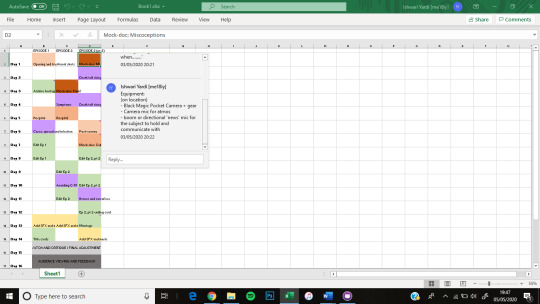
For the interviews I would like to adopt a medium/ big close up shot of the individual(s). This shot will have a shallow depth of field and bring the audiences focus purely onto the subject. However, I wish that the setting is in a comfortable location - somewhere personal, like a home setting - so that audience can build a rapport with the subjects and feel the realness of their stories (their losses and gains from Covid19). I will rely on the simplicity of the set up to make my production easy to conduct. Below is a shot from the documentary ‘Fyre’ which captures my vision well.
During the edit, I will use surrealistic slow motion shots in any intimate close ups I achieve. This will steady the pace of my narrative and allow audiences to understand the subjects vulnerability in explicitly sharing his/her story.
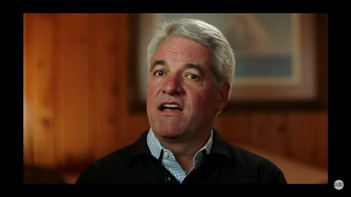
I will depend heavily on any archive footage of the peak of the virus. To do this I will opt to use news reports, stock footage and citizen journalism through social media and mine or my family/friends videos. Sources will be cited to their rightful owners.
YouTuber Shane Dawson often does this in his documentary styled investigation videos to stimulate his audience as well as provide context for his voice-overs. Dawson tends to cover quite dark or controversial topics using his dark humour to combat such existing issues in a real but subversive way.
youtube
Here are some example videos I have in mind. These are relevant to my project:
https://www.youtube.com/watch?v=oVsTnCSYAAQ
https://www.youtube.com/watch?v=rDzrAVjtbKY
https://www.youtube.com/watch?v=1U1VYck6KOo
This will be useful for any shots I was unable to achieve and will be used in various parts of my docu-series to highlight the severity of the Virus, first hand.
In recent times, cross cutting between two shots has been utilised to build non-linear narratives and make two seemingly separate topics more cohesive. I will mostly use my own shots against the animation. This will ensure that the animation doesn’t feel out of place and thus adds value to the story, especially in areas which (by the time of filming) will be unable to replicate. My animation, thus, will be drafted after the full filming production or throughout the production if I can find it easy to match up to other footage. This is shown in the excel file.
Finally, my project will rely heavily on editing i.e. within the montage for Ep. 2, Pt 2. Because of this, I will be editing my docu-series alongside the filming. This will help me spot any ‘gaps’ within the narrative early on, but also offer me an opportunity to play with the narrative sequence, see if my vision comes together.
Experimental / film-style: As earlier examined, a new style of documentary making involved film making techniques presented through a documentary narrative. For my series, I wish to employ editing styles which follows this trend closely. Here are some films which I will take inspiration from in my editing style to make this documentary visually engaging:
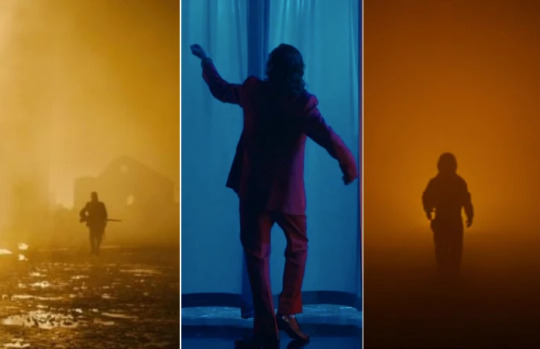

[These are not my own images]
/
*I plan to find my on-screen ‘actors’ through Facebook pages and word of mouth. I wish to find those who struggled tremendously during these times, and reach out to conflicting voices which build up our community. Speak to those:
- suffering below the poverty line
- the elderly who were in complete lockdown unable to leave their homes
- the prisoners (and police offers) trapped in 23 hour lockdown facilities
- the frontline workers - including grocery, hygiene and hospitality services
- those who faced death or lost someone close to them
- Our NHS Heroes
...(just to name a few). These interviews will seek out the most personal moments of their lives and seek emotion which I otherwise would’ve missed filming my mock-documentary.
0 notes
Text
Blog 9 - Inspiration #2
Reflective entry #2
As I am unable to construct the documentary due to the lockdown constraints, I decided to re-visit my initial ideas and adjust them according to and inline with the recent feedback I achieved. From the main criticisms, I recognised a few flaws* in my earlier constructed narrative - and, in recreating a revised draft, I took it upon myself to find new inspiration for my visuals and narrative. I also shifted my ‘mockumentary’ status to a ‘docu-film’; confronting rather than humouring aspects of Covid-19.
As this project is ‘hypothetical’ now, I believed the best plan for me was to go back to ‘the drawing board’ and construct a new narrative with more reasonable sources. One way in doing this was the mixing of genres. In the recent years, documentaries have relied on animation as a ‘fresh, dynamic approach to storytelling...of actuality’ (Kriger 2012, n.pag).
This crossing of boundaries perhaps tackles not only the issues of audience appreciating the purpose behind the construction of the documentary; but also, re-purposes my documentary for a more diversified audience (including children).
Below are some examples of creative pieces which fuse the artistic nature of film (through cinematography and animation) and the credibility of documentary.
*Such as (and especially) audience insensitivity. See below blog for more information.
1) Mani Kaul’s 1990 documentary Siddheshwari.
Kaul highlights the importance of colour in representing the vibrancy of culture, in his 1990 artful documentary: Siddheshwari. From deep blues, to the firey reds - Kaul reflectively engages his audience by the rich visuals portrayed through his masterful colour choices.

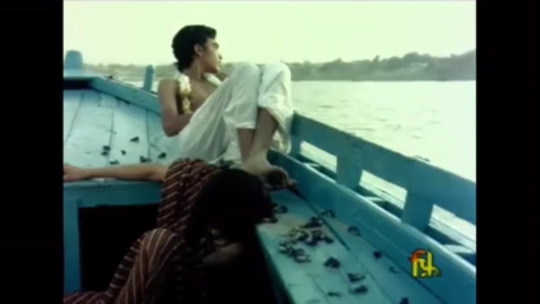
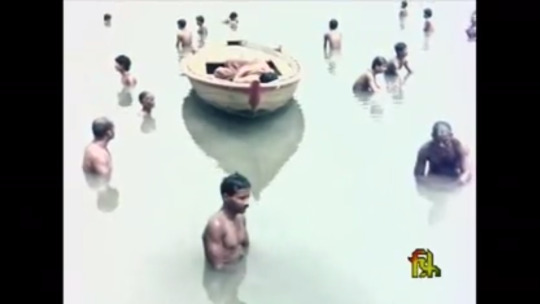
As well as this, Kaul adopts crane shots and wide angles to encapture typically filmic qualities into his documentary style of work. This is something I intend on doing through the use of new technologies and archive footage.
Some shots I intend on using are:
- Crane / drone shots from high angles. This will allow me to gain eerily still shots of town centres and time lapses of cities as they begin to flourish again.
- Medium and big close up shots for interviews. This will be placed at eye-level or even just below it for a relaxed, inviting atmosphere. I will rely on tripods to help stabilise these shots as filming will take a long period of time.
- Focus pulls to accentuate areas within the frame i.e. the background to the foreground.
- Occasional handheld footage/ BTS. I quite like this aesthetic, especially on amateur documentaries. To me, it gives a sense of authenticity to the work and reminds us of the typical ‘unseen’ clips of documentary production.
- Intentional ‘fly-on-the-wall’ shots to follow a story line and remain conventional to some degree.
- Tracking will be used to draw attention towards or away from a subject / object / area.
- Establishing shots are essential in navigating the story. The will be especially useful in determining where we are filming, what time of day and may be used as b-roll.
[This list is not exhaustive. I will still be using some shot styles as mentioned in the mockumentary research]
2) Art and animation forms
I think using physical expression art can be powerful in evoking audience emotion when reflecting on such upsetting times. Below is a sand artist who constructed a short narrative of Germany’s invasion on the Soviet Union. As shown by the clips of the audience, this artwork induced empathy and emotion for the illustrated characters.
youtube
This is true with 3D animated shorts too. The below film is extremely moving. When watching this short, I felt touched by the fictional characters’ selflessness and acts of kindness, knowing that this was just a fabricated narrative.
However, with a back story, a ‘truth’ to the narrative, perhaps this piece would’ve been more thought-provoking and have resonated with me even further.
youtube
In fact, in a recent 2017 article, Pebble Studios wrote about the importance of animation in film and documentary.
- “Animation is just another way of communicating” (ARM Sattavorn)
They note, animation has ‘evolved’; becoming an ‘art form... an experience based on what [the audience] have seen or done in the past’. The ability to relate to the characters is arguably simplest when the characters feel and think in the ways that we do, honing in on some of humanities most treasured qualities: selflessness, kindness, unity.
In the modern context, especially, animation, can depict that which we find difficult to portray in the real world i.e. the loss of loved ones, financial instabilities and so on. Furthermore, animation can be used to educate children (tackling one of the issues mentioned in the earlier blog post) without being too graphic or gruesome. For this reason, researching into animated documentaries was imperative, and here is what I found.
youtube
Global Health Media Project is a YouTube channel which educates audiences on some of the world’s worst outbreaks and uses established facts to form a narrative.
On the one hand, this combats some of the practicality issues I would’ve faced in creating the piece i.e. visiting and documenting those on the front lines/ severely ill.
However, on the other, it poses an issue: how can animation (such as those presented by Global Health) depict my intentions? And, even so, how can I do justice the two polar worlds, animation and the ‘fake’ with documentary and the ‘real’?
youtube
Because of this, I constructed spreadsheet of what I believed I could document and what would need illustrating, and (most importantly) how these worlds would collide to relate the story of Covid-19. This spreadsheet allowed me not only to organise the different narratives of each episode, and how they’d function to deliver a cohesive final project, but also with my practicality - when and where I’d shoot (see blog 11).

0 notes
Text
Blog 8 - Production
Equipment
Camera and lighting;
For the camera I will use either:
- A Black Magic Pocket Camera - due to practicality reasons and having some experience with using it in the past
- A Black Magic Ursa (Mini) - This is less practical than the pocket camera, however, it offers more creative control and I personally find it easier to use
I will rely on the locations lighting completely. I will also adjust the camera settings depending on the type / time or day of filming.
Sound;
Inspired by the use of pop. culture anthems in Asian Provocateur (2015), I too wish to adopt some form of music within my mockumentary. I believe this method can greatly add impact and humour to the narrative. However, I will use the songs sparingly as I don’t want it to showcase as a entirely fictional or over-worked medium.
To create ambience, though, I will rely on the ATMOS of the filmed medium, using a camera-mic to do this. I will also use SFX to enhance the audio-visuals further. I will use audio from my subject interviews.
The equipment I believe would be most suitable for this include:
- A boom mic - this directional microphone will allow me to pick up sound closely from the interviewer. Not only is this beneficial as it guarantees clear and crisp tonalities, but also will cut out any additional background noise
- Radio mic/ Phone - As a camera woman, I will gear myself up with a radio or transmitter mic (and in the worst case, a phone). This is because I can easily attach the mic to my clothing whilst getting really close to the mic when asking questions/communicating. The issue with this though, is if I move around, the radio-mic might (and most likely will) capture the muffled noise from my clothing and breathing. It may also clip sounds if I speak too loudly or too close to the mic.
- On camera mic (RODE) - This is a ‘back up’ mic used to pick up any ATMOS or one-to-one communication (if missed by the other mics).
Other sounds will be added during post production. All songs will be copy-right free** or used through contracted agreements.
Location shooting - all shots will be on a real location and not a set
[EDIT]
Since I have been in lockdown, unable to film my mockumentary, I decided to practise some shots and showcase how different techniques could be used
I used a compact camera to do this: Cannon G7x MKII and a short 3-leg tripod.
*I acquired some ‘test shots’ of anything that was available to film (under the lock down constrictions). It was more to practise the movements and cuts, than to get a narrative.
**For my mini-teaser, I did use copyrighted music. However this is only for testing purposes and will not be shared publicly.
0 notes
Text
Blog 7 - Pre-planning (II)
Reflective Entry #1
Pitching and Audience Engagement;
Roscoe and Hight (2001) observe that mockumentaries ‘contain a 'latent reflexivity'...'latent' because it is difficult to predict exactly how audiences will interpret these texts’ (p. 53). Because of this, it was especially important to pitch my idea to those within my stated demographic (18+) and review their feedback.
After creating my (first) presentation, I pitched it to my peers and members of a older demographic (40-50s) and noted their recognition and criticisms. Please watch this presentation to understand how drastically my ideas have changed!
youtube
Here is what I found:
:) - appreciate the ‘good’ in the ‘bad’ / humour > my audience seemed to ‘light up’ with this idea. Whether that be due to the mockumentary offering hope for its audience or due to its comic relief, the ‘panel’ seemed excited to see how this would come together and some offered their own stories to make this narrative more dense and relatable.
:) - escapism > offers us a chance to escape the troubles of our current situation
This was great feedback to hear, especially as they were understanding my aim to draw on and even generate positive energy through the mindset of: ‘every cloud has a silver lining’. However, since my mockumentary would come out after the end of Covid-19, there may be a lack of interest. People may no longer wish to look back on such traumatic times and instead forget about the loss and devastation caused by the virus.
:/ - Presenter / protagonist > In citing mockumentaries which all rely on a presenter to focus their work, there is not much clarity if you will be presenting alone, whether you will be presenting it at all or if some one else will take charge
In response to this, I think there was a little confusion with the main protagonist of my narrative because initially I didn’t have one (singular) presenter. However, in making this documentary more ‘audience friendly’ and reliable, I decided to opt for one presenter to centre the documentary around. This presenter will / would’ve been someone with quick wit and humour like either of my parents, my sibling or close friends. Practically, this is also ideal as they will be more supportive of my ideas and would be happy to make any adjustments I might have as their director (plus ‘shreditor’!). Additionally, this will keep my budget to a minimum as I will not have to ‘fork out’ for a paid presenter or actor. In documentaries ‘"people" are treated as social actors: they continue to conduct their lives more or less as they would have done without the presence of a camera. They become cultural players...their value resides...in the ways which their everyday behaviour and personality serves the needs of the filmmaker.’ (Nichols 2001, p. 5).
:( - global tragedy > I think the main issue I found with my audience, regardless or illustrating my desire to make each episode sensitive and relate to an important issue faced by a different demographic / community within society, was the issue of Covid-19 involving mass death. This period has caused utter despair for many and my audience felt as though to produce it in any other way than a standard documentary would result in a major backlash.
My main concern is not to trivialise matters. In reflecting on my script and previous work (including my presentation) I believe that the mock-documentary could be seen as a dismissive attempt to lift moral; neglecting the real issues which Britain, and many other countries, faced since the beginning of Covid-19. To combat this, I decided by loosely following Todorov’s equilibrium, disequilibrium theory, I would be able to showcase both the heartache and nationalism of the crisis. Whilst this is conventionally used in fictional films, I believe this documentary can truly benefit from this pattern of ‘normality, normality falling apart (the crisis), and normality forming again’. Thus divulge into both the negative repercussions of Covid-19 but also expose the benefits which came out of it such as those who survived, regardless of their heath and financial standings.
:( - target market > One of my criticisms involved my target market. An issue - or a positive in this case - with modern technological advancements is arguably that children are more invested into digital media like YouTube than they are the ‘great outdoors’. If this is the case, children make up a very large and reliable market for television and even for non-fiction documentaries/shows. It was suggested to me that I attempt to re-construct this show to make it more accessible to those in the brackets of 4-15 - a more family oriented show.
I found this very insightful. For instance, during such difficult times, children will have an array of questions regarding the current circumstances. What is going on? Why can’t I go to school? When can I see my friends? Just to name a few! I do believe, thus, that it would be foolish of me to discard them as a big target market.
The only challenge I’d have here, though, is to make the narrative engaging enough for the children to understand the severity of the issue, whilst not being too graphic or, on the other hand, too censored. To make the documentary informative and educational but also fun and stimulating for a much younger market - who, generally, don’t watch traditional documentaries as we know it in the ‘adult’ world.
Here are some of my own observations:
:( - Scripting > the pre-visualisation some-what compromises the ‘truth’ which I wish to explore within my period / historical marker of a mockumentary. Even in providing figments of the 'real’, I lack exposing the general truth in many ways. Perhaps this makes my series no different to the fear-inducing news in the media currently.
However, the recent #FactsNotFear campaign has inspired me to educate the audience (using limited humour) with reports and genuine facts of this extraordinary times. Furthermore, Ward (2006) argues that 'not all mock-documentaries are necessarily comedies' (p. 72). I will consider this within my own mockumentary - especially with the concerns of my market. Perhaps ‘making light out of a bad situation’ is a little naive considering the huge devastation the virus has caused.
[EDIT]
I updated my presentation and it is now available and submitted via the streaming service.
0 notes
Text
Blog 6 - Pre-planning (I)
Vision Boards;
After my initial pre-visualisation, I decided to demonstrate my ideas through vision boards i.e. how I envision rendering (and hybridising) elements of the ‘real’ through the ‘fake’ or staged. According to Roscoe and Hight (2001) ‘'faked' documentaries can be claimed as simply more recent manifestations of the tension within documentary between the need to reveal the 'truth' and typical frustrations with being able to acquire photographic evidence of the truth’ (p. 3). Meaning, perhaps, that in documenting clear and concise facts, evidencing the ‘truth’, I might compromise the visual significance of documentary aesthetics and techniques. Similarly, in making deliberate or conscious decisions in my ‘film making’, perhaps I lose sight of reflecting the truth in an authentic and credible way.
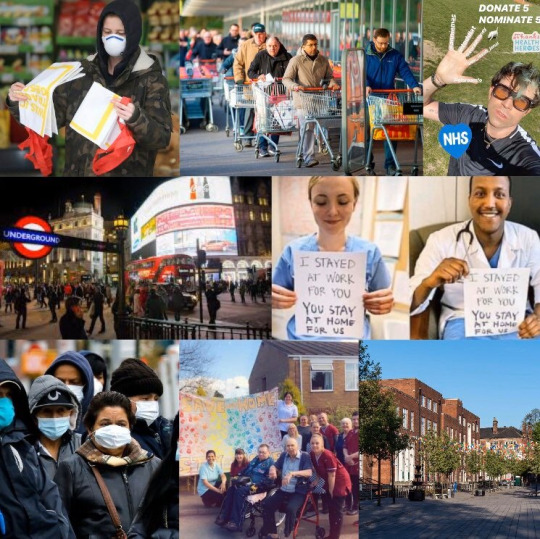
From the vision board above, my colour scheme will be mostly blues, whites and reds. Ironically, these three colours are the UK’s flag colours too; symbolising the unity and patriotism of our nation during the 2019-2020 crisis.
Vision board two illustrates shows which strongly depict my mockumentary style. These shows use conflicting camera techniques to communicate different meanings to their audience. In Asian Provocateur (2015) Romesh speaks to his camera man, making the show seem less staged and ‘friendly’, as if these sections shouldn’t have made the cut. His eyes are diverted away from the actual lens, towards an off-screen persona. Once again, this makes the show appear un-scripted and natural - he isn’t talking to his audience directly as found in shows like Come Fly With Me (2010).
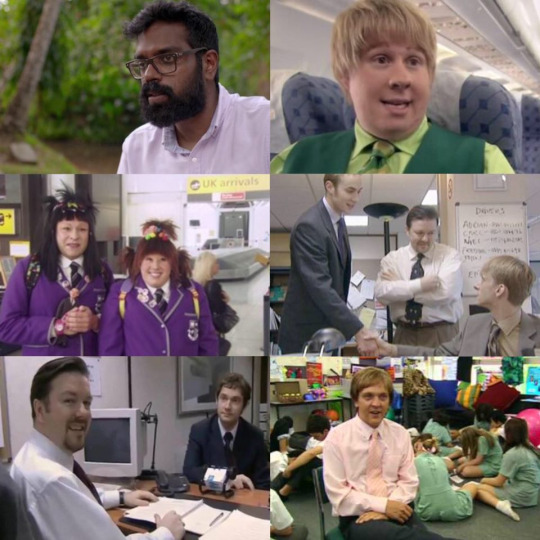
However, Mr G (the movie,) comically uses a covert styled shoot to reflect a fly-on-the-wall mockumentary. Whilst Mr G does break the fourth wall on several occasions and has one-to-one interviews with the camera crew; his larger than life on-screen character works with this. I plan to incorporate the two styles within my own project.
[The above images are not my own.]
0 notes
Text
Blog 5 - Pre-visualisation
Scripting;
I found that reading the scripts of the shows which inspired me, helped in creating structure to my pilot. For the mockumentaries which didn’t have direct or accessible scripts, I decided to read up the subtitles and see how they used documentary conventions to comically craft a narrative.
Script example 1 -

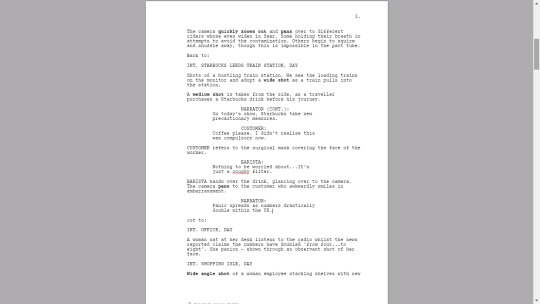
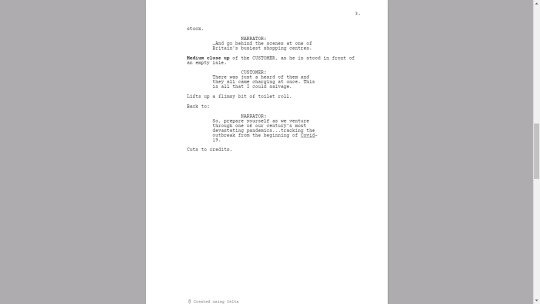
Script example 2 -
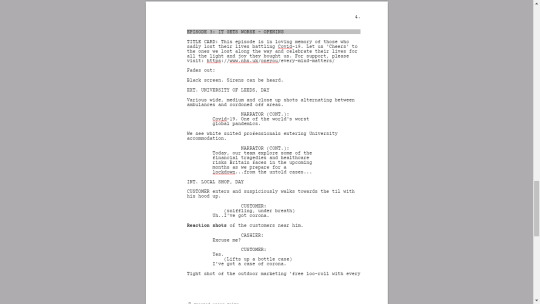
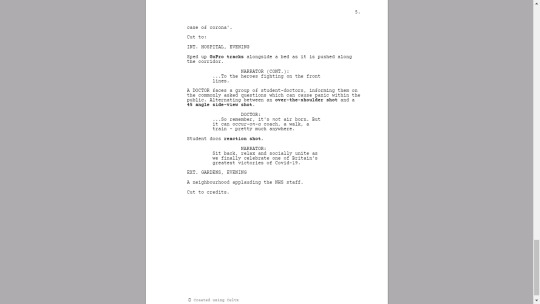
(SCENE ONE CONTINUES TO THE UNVEIL THE ‘REAL’ EVENTS WHICH TOOK PLACE FROM THE BEGINNING OF COVID-19)
All example script openings are similar to each other to remain consistent with the documentary theme.
0 notes
Text
Blog 4 - Challenges
Since the initial outbreak in December 2019, the Prime Minister has released some regulations (effective immediately) to change the daily routines of the nation. Office workers have been asked to work from home, students face a crisis as Schools and Universities close down and limitation of social interaction - even leaving the home - has taken operation. As imagined, this would’ve/will compromise the actual filming of my project.
However, due to the difficulty of this period, it was advised that no artefact was essential to the final project. Due to this, the blog will be the lead up to the production and will act as a research log of my ideas and visualisation.
The spread of the virus, itself, was much more drastic than anticipated. Whilst the narrative of the mockumentary will look into the entire experience, from the build up of the pandemic in the earlier months, to the lock-down period in more recent weeks; the speed of the societal changes will accelerate at much quicker rates than initially planned out. However, as mentioned previously, I will opt to use the most relevant stories within the crisis and thus won’t face set backs during the pre-visualisation/ lead up to filming.
Another challenge I will face is the limited objectivity of this mockumentary. Besides from bending the truth of the narrative via filming and editing pre-planned sequences (as improvised re-enactments). I could further hinder the authenticity of the narrative as I plan to adopt storyboards and scripting as a means of planning the narrative. However, in overcoming this, I will only be using stories which have been experienced in real life*, limiting the subjectivity of the production process.
*as a response to the Coronavirus i.e. panic buying, social distancing, etc.
I have decided to create a short archival video for the first few seconds of the introduction.
0 notes
Text
Blog 3 - Ideas
Brainstorming;
During my research, I found that ‘opposites attract’. Simplifying this: using two contradictory themes seemed to work well together. For example, in Asian Provocateur (2015), Romesh Ranganathan uses two very different cultures (and traditions) to ‘other’ the Sri Lankan culture - though, perhaps, not negatively - and shed light on his family heritage. Likewise, in sitcoms like Miranda (2009), Miranda Hart mocks her awkwardly, ordinary persona, in and amongst her otherwise upper-middle class family members and peers. She showcases herself as an outcast to a world in which she doesn’t fit and thus draws on a comical juxtaposition of the societal divisions.
Another observation I grasped was the challenging of boundaries - whether that be visually, comically or socially. In Come Fly With Me (2010), Matt Lucas and David Walliams challenge boundaries through the ‘mocking’ of drug usage, racism and sexual harassment. Though this is heavily controversial and led to some undesirable scandals after the show, their brand image was mostly appreciated as it met the gritty and dark (or challenging, at least) humour of their target demographic.
Nevertheless, the underlying message, behind the show, should remain to have some purpose. Whether that be a nation-wide gripping tale or an unfortunate reality to which the mockumentary confronts; the power of the social commentary works effectively through the employment of comical undertones. Once again, Come Fly With Me (2010) is a good example here. The segments in which Ian Foot - an Immigration Officer - ridicules and belittles different races, perhaps challenges the on-going racism throughout Britain, and their airports. Using stereotypes and common racially-challenging remarks jarringly reminds the audience that under the sitcom title, lies a harsh reality of modern-day racism and perhaps calls for social action to be made.
youtube
For me, I wanted to create something relevant to the market - something where the majority of individuals could relate to. As well as this I wanted to follow the research findings (as showcased above).
Due to the sudden and drastic evolution of the Corona virus, it only felt right to document such a historical moment of history. Perhaps for me, also, it was a personal aim to bring (momentary) light to my audience and provide escapism from the horror-filled media outlets which was tearing the nation apart and causing tensions to rise. This meant that I had the responsibility of documenting the spread of the virus, societal changes, and the societal response to such a frightening time.
Of course, the uncertainty of this period was challenging for me. However, an even greater challenge was in documenting this period sensitively and passionately, whilst providing some comic relief for the spectators. Rosenthal (2007) observes that commonly spectators expect ‘that a documentary should consist only of sequences filmed from real life, archival material or stills’ (p. 77). Much like in Rosenthal’s (2007) opinionated article, where he very strongly conflicts this statement, I believe that this should not, and often is not, the case. Perhaps Rotha’s (1988) suggestion is far more accurate in the modern documentary climate. Rotha (1988) notes, 'documentary's essence lies in the “dramatisation” of actual material' (p. 135).
It could be contended, thus, that in adopting true and authentic stories (experienced either by myself, my friends or my family) and somewhat ‘stretch’ or ‘bend’ the truth slightly to add more comedic value is not only relevant to my docu-comedy but also part of industry practise. Furthermore, the ‘bending’ of the ‘truth’ would occur not only through the scripting of the narrative but also the camera styles, editing and voice-over.
As mockumentaries are partially ‘docu-fiction’, I felt more flexibility in the production of the piece, having fun with the narrative and techniques used. Nevertheless, I was cautious to not elaborate these stories too much as I didn’t want to re-appropriate the documentary into a sitcom. Interestingly, however, I found that this 're-inventing’ of stories has been done previously by acclaimed nature documentaries. See clip below:
youtube
In conclusion: my final idea will be surrounding the Coronavirus and the extraordinary happenings of it there-after, with slight manipulations and exaggerated camera/ editing techniques to add comical and dramatic value to an otherwise tragic and upsetting period within history.
0 notes
Text
Blog 2 - Inspiration
After establishing that my ‘mockumentary’ would be rooted in a genre hybrid of Sitcom and documentary, I took inspiration from some of my favourite (non) fictional shows.
Documentaries / Mockumentaries -
1) Asian Provocateur (2015)
One of my biggest inspirations for this project was Romesh Ranganathan’s: Asian Provocateur (2015). A comedic pastiche exploring the vast cultural differences between the United Kingdom and Asia, Asian Provocateur (2015) documents Ranganathan’s journey through Sri Lanka. Adopting a westernised gaze, Ranganathan’s commentary becomes relatable to the westernised market and thus is suitable for a platform like Netflix, who’s largest ranking demographic lies within the US and Europe itself.
However, I was also inspired by various ‘Sitcoms' or ‘Situational Comedies’. Sitcoms, according to Dalton and Linder (2005), can be described as ‘a historical and cultural document for observing and scrutinising dominant social manners at any particular time period, especially those relating to gender, social class and relationships’ (p. 45). Sitcoms as ‘comic drama’ situate the same few characters in various scenarios and optimise ordinary locations and situations into ‘narrative comedies’ (p. 16).
Sitcoms -
1) Come Fly With Me (2010)
Come Fly With Me (2010) is a docu-fictional sitcom which explores the daily lives of airport staff and passengers across three different airlines/airports. I particularly enjoyed the conventional opening sequence at the start of each episode which showcased the upcoming programme and introduced the narrative of the show. Here is just one of the clips used in the earlier series of Come Fly With Me (2010).
From watching this show through a critical lens, I believe the narration (a well-spoken voice-over, in the style of ‘Proper English’) is particularly useful in ‘selling’ this mockumentary as a genuine documentary. This, alongside the fly-on-the-wall observational clips and medium-shot interviews further exemplifies the conventions of real documentaries. The typeography is particularly strong in this segment too as it evokes the iconography of airline signs.
youtube
2) People Just Do Nothing (2012)
Following a group of MCs running West London’s private radio station ‘Kurupt FM’, this mockumentary has many desirable qualities that I wish to explore within my own show. I especially like the interview styled scenes where audiences gain an understanding of each character’s mannerism and their motivations behind the screen.
youtube
Relying on pop-cultural references and humour which is only truly applicable to the British spectator; this show embodies fly-on-the-wall filmmaking which is particularly interesting through the shaky handheld footage approach.I also enjoy the various establish shots and how the interviews are commonly set in ‘authentic’ locations, true to the character’s personality. Whilst Grinda (the protagonist) commonly breaks the fourth wall, we (as an audience) are still immersed admits the happenings of their daily lives.
3) Miranda / Peep Show / The Office UK
These three shows are particularly striking to me as they follow their protagonists in rather ordinary scenarios, which somehow commonly are revealed to be quite unfortunate for them. These awkwardly tragic segments perhaps lead to a type of personal identification and reliability which the audience gain through mockumentary styled realism of the show.
Nevertheless, Miranda (2009) breaks the fourth wall to draw audiences into her personal journey. Whilst Miranda is scripted, we often feel like the show has an authentic flow in which the characters personas are unique and not overly planned out. Likewise, Peep Show (2003) uses POV shots as a means of immersion for the spectators - we are quite literally amid the action of the sequence. Additionally, we encounter first-hand perspectives of both Mark and Jeremy - or at least enter the conscience mind of the protagonists - during their daily routines. These shows, whilst in many ways relatable, cross the boundaries into sitcom.
youtube
The Office UK (2001), however, remains more conventional to the mockumentary style. Adopting interviews as a main source of character development and fly-on-the-wall visuals, this show epitomises the docu-fiction narrative I wish to create within my own documentary brief.
youtube
In accordance with Koshi (2013), the ultimate aim of a mockumentary is to appropriately ‘[stage] techniques [to] present fictional work as a non-fictional documentary’ (p. 111). Whilst Koshi (2013) uses this to demonstrate how these staging techniques are utilised within the Horror genre, I find her argument very relevant with the above case studies.
From what I have gathered, my research shows that each mockumentary or sitcom uses similar technical codes and conventions. The camera techniques, in particular, highlight the ‘staging’ mentioned earlier by Koshi et al (2013). Below are examples of some techniques which I found to be particularly relevant:
- Over the shoulder shots - positioning the camera behind the protagonist. Whilst this isn’t necessarily a POV shot as such, we are able to engage with the protagonist more closely - see as they are. Likewise, this method sets us up close to the action, a technique rarely used within non-fictional forms or documentaries.
- Handheld footage, moving to follow the subject in frame - this is where the camera man holds the camera in his/her hand or on their shoulder, often without the support of a stabiliser i.e. a gimbal. With very little stability, audiences experience every movement which the camera makes, from a small nudge to a jerking action (or pan). This is useful within mockumentaries as it ‘sells’ the false claim of authenticity. Audience are led to believe that the narrative is raw, un-cut and, at times, even amateur.
- Pans, tilts, tracks - A camera movement. Pan, tilts and tracks all involve the camera moving toward or away from the action / subject. Whilst tracks aren’t so commonly used in mockumentaries, pans and tilts are. They visually showcase the comedic ‘punchline’. Perhaps we have a line or comment which builds comedic tension, and then we pan to the object, subject or action which makes the narrative funny. This is heavily adopted through out both sitcoms and mockumentaries, suggesting a level of staging behind these camera movements.
- Zooms - Unlike the pan, tilt and tracking shots mentioned above, the zoom is not a camera movement but instead an adjustment. We zoom in to the subject, object or action cropping and compressing the surroundings - this is unlike the other techniques which physically move in/out, and do not crop the frame. This can be adopted when someone is observing from a-far; perhaps they notice something the subject is doing which seems a little inappropriate or sketchy. Its a style of ‘exposure’ through a voyeristic stance.
- Medium/Big close up shots, very rarely wide shots
These will be considered during my pre-visualisation and filming of the mockumentary.
0 notes
Text
Blog 1 - The Documentary
According to Jong, Knudsen and Rothwell (2014) a 'documentary is perhaps best described as a hybrid film genre which attempts to represent the 'real' in a creative and critical art form'. Origins of the first documentary date back to the 1920s in which Robert J. Flaherty captured an ethnographic gaze, exploring the lives of Canadian Inuit Eskimos living in the Arctic. However, according to some scholars, Nanook of the North (1922) wasn’t the first non-fictional film to document the ‘real’. In 1895, for example, the Lumière Brothers recorded workers entering and leaving the Lumière Factory. Perhaps, thus, it is hard to precisely locate the origins of documentary making, and even its initial purpose.
youtube
Over the past century, nonetheless, the meaning of the term ‘documentary’ has changed drastically; perhaps, with less focus on ‘the 'real' and more so on the producer’s ‘creative and critical art form'. During the first workshop tutorial, we discussed a more contemporary term for these subjective documentaries: Docu-fiction. Docu-fiction relies heavily on fictional elements in order to present the ‘truth’ through a distorted light. One form of Docu-fiction is, perhaps, the modern Mockumentary. Reliant on (staged) improvisation and dominated through intentional cuts and camera movements, the mockumentary presents a false reality. However, mockumentaries often provide comic relief to the otherwise serious motives of the conventional documentary, something which I intend on exploring within my own production.
Wallace (2018) cites Roscoe and Hight as they suggests that ‘”the mock-documentary form seems...to parody aspects of popular culture...”’. In his book Mockumentary Comedy: Performing Authenticity, he observes that scholars, such as Roscoe and Hight, categorise the sub-genre as a satirical expression, a parodic homage to documentary’s generic tropes and conventions. Nevertheless, Wallace (2018) conflicts this, suggesting ‘mockumentaries...no longer adhere as strictly to documentary conventions as might once have been the case...’. Mockumentaries, in television’s contemporary landscape, employ their own codes, narrative hooks, ideologies (p. 19-20). He continues, in spite of their traditions rooting from documentaries, ‘...mockumentaries have always had a wider agenda than simply critiquing the documentary genre’. Perhaps attention needs to be focused on the narrative of my mock-documentary, and questions regarding the purpose of constructing the documentary (in the first instance) must be recognised.
I will, therefore, aim to explore beyond just the technical parodies and conventions of documentaries, whilst simultaneously remaining generically recognisable.
1 note
·
View note